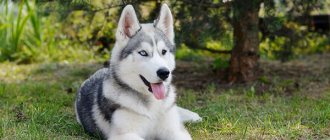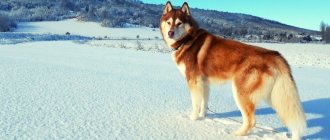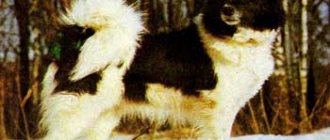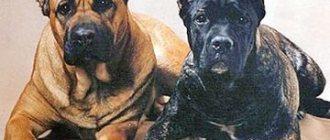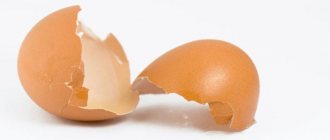Many people who are not very well versed in dog breeding confuse huskies and huskies and do not know what the difference is between them.
Indeed, there are many similarities between these two breeds, however, they have no less differences.
Moreover, this applies not only to the exterior, but also to the characteristics of the psyche, character, temperament and even purpose.
All this must be taken into account when keeping, raising and training these dogs, and therefore, anyone who is thinking about purchasing a husky or husky needs to study the similarities and differences of these two dogs before purchasing a puppy.
This will not only help provide the pet with the most suitable living conditions, but will also save their owners from disappointment in the future.
Brief information about Husky
Photo and description
The dog is of medium height (approximately from 50 to 60 cm at the withers, weight is about 15-28 kg), compact, but at the same time harmonious build.
The body is slightly stretched and exceeds the height at the withers by no more than 2-3 cm; the shape of the head from above resembles a triangle, slightly tapering towards the muzzle. The stop is well defined, but not sharp.
The length of the muzzle is approximately equal to the length of the cranial part of the head.
The ears are erect, triangular, of medium size, set quite close to each other.
The eyes are almond-shaped, slightly slanted. Their color can be blue, brown, amber, olive. In addition, different eye colors .
IMPORTANT!
The nose, as well as the pigmentation of the lips and rims of the eyelids, depending on the color, can be black or brownish.
The neck is of medium length, the chest is deep and powerful, but not too voluminous. The forelimbs are moderately wide, even and parallel. The hind legs are muscular, with well-defined angulations of the hock joints. The tail is similar to a fox's, in a calm state it is lowered downwards, but when alert, it is carried in the form of a sickle over the back.
The coat is not too long, two-layered, while the undercoat is thick and soft, and the coarser hair is quite smooth and adjacent to the body. The color can be almost any, although the most typical colors for huskies are grey-white, black-and-white, brown-white and reddish-white.
Advantages and disadvantages
Pros:
- Intelligence and intelligence.
- Ability to make decisions independently when necessary.
- Lack of aggression towards humans.
- Love for children and playful disposition.
- Loyalty to the owner.
- Endurance and unpretentiousness.
- Easy hair care.
- They make excellent sled or sport dogs.
Minuses:
- Not suitable as guard dogs.
- Tendency to dig up the earth.
- Sometimes they are headstrong and stubborn.
- They often howl.
- They can be aggressive towards smaller animals.
- They need a lot of physical activity and long walks.
- Out of boredom, they can start to damage things in the house.
Character
Lively and friendly towards people. Huskies, unless serious mistakes were made during their upbringing , are never aggressive towards humans and are not inclined to bite.
Friendliness towards strangers and lack of territorial instinct make these dogs poor guards and this must be taken into account by people thinking about purchasing such a pet.
Huskies have an innate hunting instinct, but they will not make hunters either. These dogs hunt for game only for their own food and will never give it up to their owner of their own free will.
These are independent, independent, and sometimes stubborn and willful animals, prone to running away and wandering.
In addition, huskies love to dig up the ground and, out of boredom, can chew furniture, tear off wallpaper, or howl like wolves.
However, when keeping these dogs in the house, you need to take into account that most of the bad habits of a husky are easy to remove or simply prevent them from appearing in your pet. This is achieved through early socialization and proper education and training.
In addition, as noted above, huskies act out mainly from boredom and idleness, and therefore, if you provide the dog with sufficient mental and physical stress, it simply will not have time for mischief.
Interesting Facts
It is unlikely that any exceptional facts specifically for this breed will be found on the Internet, but there are interesting points:
- In Ancient Rus', according to the laws of the 14th century, large dogs were the most valuable domestic animals, because they could be exchanged for 3 horses, a herd of sheep or one working ox.
- At the beginning of the 18th century in feudal Japan, killing a dog was punishable by death, and people were required to bow when meeting stray animals and show them signs of respect.
- The number of teeth in an adult dog is 1.5 times greater than in puppies.
- Dogs' sense of smell is hundreds of thousands of times stronger than that of humans, but their vision is not as clear as humans.
- All dogs hear ultrasound. Considering this scientifically proven fact, Paul McCartney inserted several analog sounds at the end of the musical composition “One Day in the Life” especially for his beloved pet.
- Laika, by description and nature, is a predator, so the diet must be appropriate. In the North of Siberia and Chukotka, local residents specially stock up on food for sled dogs, most of which consist of huskies, troublemakers and huskies - yukola from weed fish. These stocks are light in weight and can be stored for several months even in the hot summer.
- The husky may smell like corn chips, but this does not mean that the dog stole a treat somewhere - the cause may be microbes that have accumulated between the toes. You need to examine your pet more often and monitor its hygiene.
All huskies are distinguished by their special friendliness and kindness, and at a young age they are especially playful. But you need to know the dog’s habits thoroughly - if it waves its tail to the left, then this is an alarming signal, the dog is excited and very aggressive.
A little about likes
Photo and description
Laikas are not representatives of one breed, but a breed group that unites several dogs similar in origin, appearance and purpose.
Most huskies are hunting dogs, although many are also suitable for other work. For example, the Nenets Laika is excellent at herding deer, and the Yakut Laika can be used not only for hunting, but also as a sled dog.
In terms of their physique and coat characteristics, huskies are very close to dogs of the so-called wild or wolf type. Moreover, representatives of different breeds of huskies differ from each other, first of all, in the structure of the head and muzzle.
All of them are characterized by a strong, but not squat, build, as well as pointed, erect ears and a tail curled into a full or incomplete ring.
The coat of these dogs is not too long, but at the same time very dense and thick, with an abundant, moderately soft undercoat.
Laikas can come in a variety of colors, but the most typical coat colors are wolf, gray or black, often accompanied by white markings of various shapes and sizes.
Advantages and disadvantages
Pros:
- Excellent hunting dogs, suitable for tracking a variety of game.
- Hardy and unpretentious.
- They are distinguished by good health and, often, long life expectancy.
- Balanced and calm character.
- Devotion and obedience.
- Goodwill towards people, which, however, does not prevent huskies from being good guards.
- Undemanding to nutrition.
Minuses:
- Not suitable for keeping in an apartment.
- Hunting huskies may be at risk of contracting a serious infection in the forest or field.
- Very strong shedding.
- Despite their devotion, they can become disobedient when chasing game.
Character
Laika is quite independent and proud; she recognizes only partnerships with her owner and does not tolerate either excessive familiarity or rudeness in handling herself. This is a very smart and quick-witted animal, which, depending on the current situation, can make its own decisions during the hunt.
Laikas are friendly towards people and make good companions for children, especially since most of these dogs have a cheerful and playful disposition. Laikas are distrustful of strangers, but without increased aggression.
NOTE!
These dogs have an innate viciousness and ruthlessness towards prey, therefore, huskies need early socialization, without which they can be dangerous to pets smaller than themselves.
Similarities
Despite their external differences and behavioral characteristics, dogs still have similarities. Let us highlight the main qualities that both breeds have in common:
- relationship of origin - both breeds are close to the wolf, cultivated in the North;
- active, temperamental, love fresh air, can withstand frost;
- accustomed to dog groups, they get along in a pack of their own kind;
- devoted to the owner;
- efficient, accustomed to following commands.
Both breeds will not snooze all day in a corner on a rug; they require long walks, running and air.
Main differences
The main characteristics by which huskies and huskies differ:
- Huskies have a denser and more muscular build, while huskies are taller and have lighter bones.
- Huskies' ears are rounded at the ends, while huskies' ears are pointed.
- Husky paws are wider, stronger and more powerful than those of huskies.
- Laikas have rounder eyes, while Huskies have almond-shaped eyes. In addition, the eye color of a husky can only be dark, and not blue or heterochromic, like that of a husky.
- The look of a husky expresses curiosity and energy, while the look of huskies shows balance, attentiveness and some wariness.
- The fur of huskies is coarser in texture than that of huskies.
- The husky's tail is held downwards or in the shape of a sickle, while in huskies it is curled into a complete or incomplete ring.
- Huskies are larger in size: their height reaches 60 cm and their weight is 28 kg, while huskies are smaller and weigh more than 23 kg.
Huskies are larger and heavier than huskies, they have stronger bones and better developed muscles. Laikas look taller and lighter-boned compared to them.
Husky ears are rounded at the ends, while husky ears are sharper, and eyes can be not only brown, but also blue and even different colors. Laikas can be exceptionally dark-eyed, and their gaze is calmer and more serious than that of a husky.
The main external difference between the husky and the husky is that the husky’s tail is wrapped in a ring, while the husky’s tail resembles a fox’s and hangs down when at rest.
Common features
The main external similarity of these dogs is their erect ears, as well as a wedge-shaped head and a slightly pointed muzzle.
The coat of a husky and a husky also has a similar structure - it is very dense and dense, consisting of a soft undercoat and a coarser and tougher awn.
Both huskies and huskies look like strong and hardy animals, and they also both have some external resemblance to wolves.
Advantages
| Laika | Husky |
|
|
Who is easier to maintain and care for?
Despite the popular belief that Huskies are not easy to keep indoors, caring for these dogs is not difficult. Representatives of this breed require infrequent brushing, occasional bathing as needed, and eye, ear, and nail care. Only during shedding do they need to be brushed daily.
In huskies, shedding is more pronounced than even in huskies, which makes caring for them somewhat more difficult. In addition, these dogs' fur has a coarser texture, making it more difficult to remove from clothing, carpets and upholstered furniture.
IMPORTANT!
When caring for and maintaining hunting huskies, you should never neglect treating your pet for parasites and timely vaccinations, since these dogs are prone to infectious diseases transmitted from other animals or carried by external parasites.
How to distinguish puppies?
Many people wonder what is the difference between husky and husky puppies (look at the photo below). The main difference between the dogs is very noticeable when visually compared: huskies look serious, frowning thanks to their signature color. The husky puppy looks like they are smiling:
Husky/Laika
Attitude towards children and pets
Both huskies and many huskies have a cheerful and playful disposition and are good with children.
However, some breeds of huskies are not recommended as pets for families with children, as their nature is too stern and independent for these dogs to calmly deal with children who bother them or tease them.
As for the attitude of these dogs towards other domestic animals, huskies, who do not have innate malice towards the beast, are more tolerant of them than huskies.
Origin
Husky is an ancient breed that appeared thanks to the northern peoples. For a long time, dogs lived next to the Chukchi of northeastern Siberia and served as sled dogs.
In the first half of the 20s of the 20th century, during the gold rush in Alaska, Americans became interested in animals and began to actively breed them in the USA. Soviet cynologists considered the breed unpromising and only appreciated it in the mid-1990s.
Unlike huskies, huskies are a whole group of breeds with an incompletely clarified history. The most ancient images of similar dogs were found on the frescoes of the temple from the times of Kievan Rus. The following mentions of huskies belong to the late period and date back to the mid-19th century, when breeders began work to improve the breed.
Who is more picky about feeding?
Both dogs can eat both home-cooked and commercially prepared food and are not particularly picky about what they feed.
However, you need to take into account that huskies are more prone to overeating, and therefore it is necessary to take a more responsible approach to their diet and not supplement the pet between feedings.
Comparison by other criteria
Aggression towards people
Uncharacteristic of either huskies or huskies.
But at the same time, the latter can treat strangers with distrust and can even be good guards, while huskies are friendly towards all people and because of this are completely unsuitable for protection.
Activity and exercise
Both dogs require a lot of exercise and are energetic and active. There are almost no differences in this matter.
Lifespan
The difference here is that huskies live on average 12-14 years, while the life expectancy of huskies can reach 17 years.
Price difference
The cost of husky puppies with documents starts from 15 thousand.
A small husky can be purchased for 5-10 thousand, however, if we are talking about purchasing a dog from parents who have shown excellent results in hunting, then its cost may be slightly higher.
Russian-European
A hunting dog of a square format with a lean, muscular build. In height, males reach 52-58 cm, and females 50-56 cm. Representatives of the breed weigh 18-25 kg . A distinctive feature is black and white or pure black colors. Outwardly, the most sophisticated and graceful Laika. They hunt any game, but require some preparation. They can serve as guards.
The USSR (Russia) is considered the birthplace of the breed. The breed has been recognized since 1980. Belongs to the 5th group and the second section.
Unpretentious pets that can adapt to life in a city apartment. The best option would be an enclosure. Animals need to move a lot and actively, hunt, run. It is necessary to provide the dog with proper physical activity.
The cost of Russian-European Laikas depends on their pedigree and working qualities. For a middle-class pet you will have to pay from 15 to 20 thousand rubles. If the dog is mature and trained, the price increases.
Who should you choose?
When choosing who to buy, you must, first of all, proceed from the purpose of the future pet. If you need a hunting dog, then you need to buy a husky, but if you need a dog for sledding, then you should buy a husky.
Conditions of detention are also of great importance. Laikas are not suitable for living in an apartment, while huskies tolerate indoor living quite well, provided they receive sufficient physical and mental exercise.
NOTE!
For families with small children, a husky is better suited, since not all huskies can be kind to kids, but at the same time they will make wonderful friends for older children.
Training
It is believed that huskies are more obedient and easier to train and train than huskies. In any case, you need to start training your puppy as soon as you purchased it. You need to start with socialization, introduce him to all family members, house, apartment, walking areas.
It is imperative to enforce prohibitions; if violated, it is not recommended to hit the dog . But at the same time, it is necessary to praise and treat your pet when the results are positive. A husky will obey its owner if this person has proven that he is the boss in the house. For this breed, it is important to understand who the leader is in order to fulfill his requirements.
